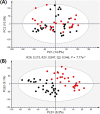Plasma amino acids and oxylipins as potential multi-biomarkers for predicting diabetic macular edema
- PMID: 33958610
- PMCID: PMC8102569
- DOI: 10.1038/s41598-021-88104-y
Plasma amino acids and oxylipins as potential multi-biomarkers for predicting diabetic macular edema
Abstract
To investigate the pathophysiologic characteristics of diabetic complications, we identified differences in plasma metabolites in subjects with type 2 diabetes (T2DM) with or without diabetic macular edema (DME) and a disease duration > 15 years. An cohort of older T2DM patients with prolonged disease duration was established, and clinical information and biospecimens were collected following the guidelines of the National Biobank of Korea. DME phenotypes were identified by ophthalmologic specialists. For metabolomics studies, propensity matched case and control samples were selected. To discover multi-biomarkers in plasma, non-targeted metabolite profiling and oxylipin profiling in the discovery cohort were validated in an extended cohort. From metabolomic studies, 5 amino acids (asparagine, aspartic acid, glutamic acid, cysteine, and lysine), 2 organic compounds (citric acid and uric acid) and 4 oxylipins (12-oxoETE, 15-oxoETE, 9-oxoODE, 20-carboxy leukotriene B4) were identified as candidate multi-biomarkers which can guide DME diagnosis among non-DME subjects. Receiver operating characteristic curves revealed high diagnostic value of the combined 5 amino acids and 2 organic compounds (AUC = 0.918), and of the 4 combined oxylipins (AUC = 0.957). Our study suggests that multi-biomarkers may be useful for predicting DME in older T2DM patients.
Conflict of interest statement
The authors declare no competing interests.
Figures




Similar articles
-
A dynamic nomogram for predicting diabetic macular edema in type 2 diabetes patients based on plasma cytokines.Aging (Albany NY). 2021 Mar 3;13(6):8369-8379. doi: 10.18632/aging.202647. Epub 2021 Mar 3. Aging (Albany NY). 2021. PMID: 33686950 Free PMC article.
-
Plasma metabolomic profiling of diabetic macular edema.Sci Rep. 2025 Mar 23;15(1):10012. doi: 10.1038/s41598-025-94759-8. Sci Rep. 2025. PMID: 40122941 Free PMC article.
-
Plasma glutamine and glutamic acid are potential biomarkers for predicting diabetic retinopathy.Metabolomics. 2018;14(7):89. doi: 10.1007/s11306-018-1383-3. Epub 2018 Jun 21. Metabolomics. 2018. PMID: 29950956 Free PMC article.
-
Peripheral blood metabolic and inflammatory factors as biomarkers to ocular findings in diabetic macular edema.PLoS One. 2017 Mar 22;12(3):e0173865. doi: 10.1371/journal.pone.0173865. eCollection 2017. PLoS One. 2017. PMID: 28328965 Free PMC article.
-
Association of Bone Metabolic Markers With Diabetic Retinopathy and Diabetic Macular Edema in Elderly Chinese Individuals With Type 2 Diabetes Mellitus.Am J Med Sci. 2017 Oct;354(4):355-361. doi: 10.1016/j.amjms.2017.07.003. Epub 2017 Jul 10. Am J Med Sci. 2017. PMID: 29078839 Free PMC article. Clinical Trial.
Cited by
-
The regular pattern of metabolite changes in mushroom Inonotus hispidus in different growth periods and exploration of their indicator compounds.Sci Rep. 2022 Aug 23;12(1):14354. doi: 10.1038/s41598-022-18631-9. Sci Rep. 2022. PMID: 35999354 Free PMC article.
-
Effects of Danggui Buxue decoction on host gut microbiota and metabolism in GK rats with type 2 diabetes.Front Microbiol. 2022 Oct 24;13:1029409. doi: 10.3389/fmicb.2022.1029409. eCollection 2022. Front Microbiol. 2022. PMID: 36353458 Free PMC article.
-
Identification and mechanistic analysis of neurovascular coupling related biomarkers for diabetic macular edema.Front Mol Biosci. 2024 Sep 13;11:1332842. doi: 10.3389/fmolb.2024.1332842. eCollection 2024. Front Mol Biosci. 2024. PMID: 39347501 Free PMC article.
-
Untargeted Multiomics Approach Coupling Lipidomics and Metabolomics Profiling Reveals New Insights in Diabetic Retinopathy.Int J Mol Sci. 2023 Jul 27;24(15):12053. doi: 10.3390/ijms241512053. Int J Mol Sci. 2023. PMID: 37569425 Free PMC article.
-
Cross-Sectional Associations between Prenatal Per- and Poly-Fluoroalkyl Substances and Bioactive Lipids in Three Environmental Influences on Child Health Outcomes (ECHO) Cohorts.Environ Sci Technol. 2024 May 14;58(19):8264-8277. doi: 10.1021/acs.est.4c00094. Epub 2024 May 1. Environ Sci Technol. 2024. PMID: 38691655 Free PMC article.
References
-
- Kempen JH, et al. The prevalence of diabetic retinopathy among adults in the United States. Arch. Ophthalmol. 2004;122:552–563. - PubMed
-
- Cheung N, Mitchell P, Wong TY. Diabetic retinopathy. Lancet. 2010;376:124–136. - PubMed
-
- Fathy C, Patel S, Sternberg P, Jr, Kohanim S. Disparities in adherence to screening guidelines for diabetic retinopathy in the United States: a comprehensive review and guide for future directions. Semin. Ophthalmol. 2016;31:364–377. - PubMed
Publication types
MeSH terms
Substances
LinkOut - more resources
Full Text Sources
Other Literature Sources
Medical

